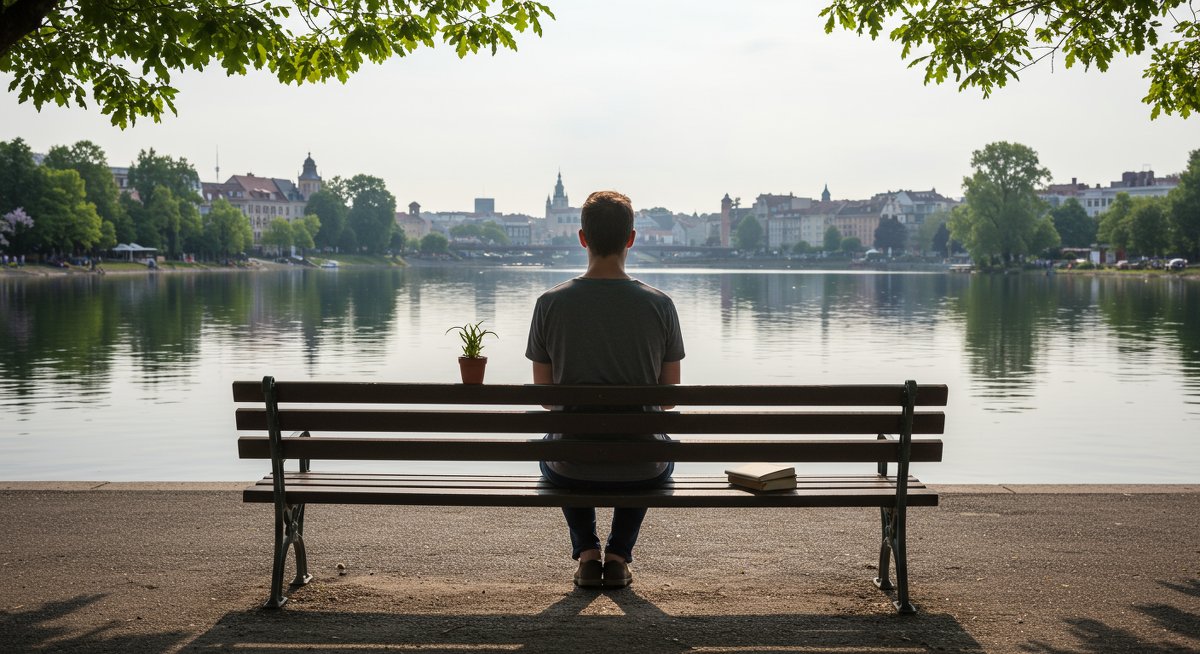Embarking on the digital nomad journey is exciting, promising freedom, adventure, and a life lived on your own terms. However, the transition isn't always smooth. The nomadic lifestyle can present mental health challenges, including loneliness, burnout, and stress. This guide is designed to support you in prioritizing your well-being and building a sustainable, fulfilling life on the road. We'll explore strategies, resources, and steps you can take to thrive mentally and emotionally as you embrace location independence. This is about more than just surviving; it's about thriving and enjoying every moment of your journey.

Why embracing mental health matters for your nomad journey
Your mental health is the foundation upon which your entire digital nomad experience is built. Without a strong mental foundation, the challenges of remote work and travel can quickly become overwhelming. Loneliness, a common issue for nomads, can lead to feelings of isolation and depression. The constant need to adapt to new environments, time zones, and cultures can cause stress. And the pressure to always be productive can lead to burnout. Prioritizing your mental health isn’t just about avoiding problems; it's about unlocking your full potential and truly enjoying the freedom and flexibility of the nomad lifestyle. It allows you to be resilient, embrace new experiences with confidence, and build a life that aligns with your values and goals. Mental wellness is your superpower on the road.
To illustrate, imagine Sarah, a content writer who initially thrived as a nomad. However, after several months, the constant travel and lack of a stable routine started to take a toll. She began experiencing anxiety and struggled to stay motivated. By recognizing these issues and actively prioritizing her mental health – through therapy, mindfulness, and connecting with other nomads – Sarah was able to reclaim her joy and sustain her nomad journey. This underscores the importance of proactive mental health care.
Essential first steps to become a digital nomad
Before you even book your first flight, take time to prepare mentally. This involves self-assessment, planning, and building a support system. Start by identifying your personal triggers and vulnerabilities. What situations or environments tend to cause you stress or anxiety? Understanding these patterns can help you proactively manage your mental health. Create a flexible daily routine, incorporating activities that promote well-being, such as exercise, meditation, and social connection. Research mental health resources available in your target destinations, including therapists, support groups, and crisis hotlines. Building a strong network of friends and family, both online and offline, is also crucial. Knowing that you have people to turn to when you need support can make a huge difference. Remember, a strong start is key.
For example, consider Mark, who before embarking on his nomad journey, spent several weeks creating a detailed mental health plan. This included identifying his stress triggers (such as unreliable internet and language barriers), establishing a daily mindfulness practice using the Calm app, and researching therapists specializing in remote work. This preparation equipped Mark with the tools and strategies needed to navigate the challenges of the nomad life, allowing him to enjoy his travels and maintain his well-being.
Common beginner challenges & how to overcome them
As a new digital nomad, you'll likely face a range of mental health challenges. Loneliness is a prevalent issue, especially when starting out. You're often away from familiar faces and routines. Combat this by actively seeking out social connections. Join online communities, attend meetups, and reach out to fellow travelers. Another major challenge is managing stress. The constant travel, unreliable internet, and adapting to new cultures can lead to high levels of stress. Implement stress-reduction techniques, such as mindfulness, deep breathing exercises, and regular breaks. Make sure your workspace is set up properly and ergonomic to minimize physical discomfort. Burnout is also common, as the pressure to be productive and the lack of a clear work-life balance can lead to exhaustion. Establish clear boundaries between work and leisure. Schedule regular breaks, and make time for activities you enjoy outside of work. Prioritize your well-being by incorporating activities that bring you joy into your daily routine. It’s okay to slow down and take care of yourself.
Consider this scenario: Emily, a freelance graphic designer, struggled with loneliness and burnout during her first few months of nomadic life. To combat this, she started attending co-working events to meet other people. She also started using the Meetup app to find local groups based on her interests. Additionally, she implemented a strict work schedule, setting specific working hours and taking regular breaks to explore her new surroundings. Through these actions, Emily significantly improved her mental health and adapted more successfully to the nomad lifestyle. These are the types of adjustments that can make a difference.
Tips for success
To successfully navigate the mental health aspects of the nomad lifestyle, you need to be proactive and create habits that support your well-being. Start by creating a daily routine. Consistency can provide a sense of stability and control amidst the chaos of travel. Include activities like exercise, meditation, journaling, and socializing. Make sure to budget for your mental health. Consider the cost of therapy, mindfulness apps, or other resources that support your well-being. Finding and maintaining healthy relationships is also crucial. This means building a strong network of online and offline connections. Foster your existing relationships and cultivate new friendships with fellow travelers and locals. Don’t underestimate the power of social support. Lastly, set realistic expectations. The digital nomad life is often idealized, but it has its challenges. Be prepared for setbacks, learn to embrace imperfection, and be kind to yourself.
For instance, take the case of John, who made mental well-being a top priority from the outset. He allocated a monthly budget for therapy sessions via an online platform, used the Headspace app daily for guided meditation, and connected with other nomads through co-working spaces. This proactive approach not only helped John navigate the stress of finding a remote job but also allowed him to fully embrace the freedom and flexibility of his new lifestyle.
Building a sustainable nomad lifestyle
Building a sustainable nomad lifestyle requires more than just having a remote job and a plane ticket. It means creating a life that supports your mental, physical, and emotional well-being long-term. Focus on creating a balance between work and leisure. Set clear boundaries between work hours and personal time. Make sure to schedule regular breaks and vacations to avoid burnout. Cultivate a sense of community. Connect with fellow nomads, locals, and people who share your interests. Consider joining online groups, attending meetups, or volunteering in your destinations. Develop healthy habits. Prioritize sleep, exercise, and a balanced diet. These are foundational for maintaining your mental health. Be adaptable and embrace change. The nomad life is full of surprises. Learn to embrace the unexpected and view challenges as opportunities for growth. This is a journey, not a destination; allow yourself to evolve.
For example, consider Maria, who started her nomad life with a focus on her career but soon felt overwhelmed. To build a more sustainable lifestyle, she started dedicating a few hours each week to exploring her interests, such as learning a new language and practicing yoga. She also joined a local hiking group, which provided her with both exercise and social connection. This holistic approach to her well-being allowed Maria to thrive and enjoy a much healthier and more sustainable lifestyle.

Recommended resources for new nomads
Fortunately, many excellent resources can support your mental health journey as a digital nomad. Consider using meditation and mindfulness apps. Calm and Headspace offer guided meditations, sleep stories, and relaxation exercises. Explore online therapy platforms. Platforms like Talkspace or BetterHelp can connect you with licensed therapists specializing in remote work. Look for community and support groups. Websites and apps like Meetup and Facebook groups provide opportunities to connect with fellow nomads. Travel insurance plans often include mental health support. Make sure to check the terms of your insurance policy for coverage for mental health services. Don't hesitate to reach out for support; there are many resources available to help you thrive.
To illustrate, consider Robert, who, upon starting his nomad journey, subscribed to the premium version of the Calm app. He found it incredibly helpful for reducing stress and improving sleep. Additionally, he joined a Facebook group for digital nomads, where he could share experiences, seek advice, and find support from others navigating similar challenges. These choices significantly improved his mental health during the early stages of his nomad life.
Quick wins for your first nomad trip
Even before your first trip, you can take steps to proactively manage your mental well-being. Begin by planning your trip in advance. Research your destination thoroughly, including local mental health resources and support groups. Pack a “well-being kit.” Include items such as a journal, essential oils, comfort items, and any medications you take regularly. Set up a support system. Inform your family and friends about your plans and schedule regular calls and video chats. Create a daily routine that incorporates healthy habits such as exercise and meditation. Prioritize your sleep. Get adequate sleep and try to maintain a regular sleep schedule to avoid fatigue. Finally, practice mindfulness. Take breaks throughout the day to focus on your breath and be present in the moment. These small steps can make a big difference in ensuring a successful and enjoyable nomadic experience.
For example, consider a scenario: Before embarking on her first nomad trip, Susan created a “well-being kit” containing her favorite tea, a gratitude journal, and a list of calming music. She also downloaded the Calm app and scheduled daily meditation sessions. These preparations helped her manage anxiety and made her first trip a success. By taking these measures, Susan successfully prepared for her adventure, supporting her mental health from the start.
Next steps in your location independent life
As you continue on your digital nomad journey, remember that prioritizing your mental health is an ongoing process. Regularly assess your well-being. Reflect on how you’re feeling, identify any challenges, and adjust your strategies accordingly. Seek professional help when needed. Don’t hesitate to consult with a therapist, counselor, or psychiatrist if you’re struggling. They can provide valuable support and guidance. Continue to build your support network. Nurture your existing relationships and seek out new connections. Embrace self-care as a priority. Schedule time for activities that bring you joy and relaxation, and don't feel guilty about it. The digital nomad life is full of opportunities, and your mental health is your most important asset. By making it a priority, you can ensure a fulfilling, sustainable, and enjoyable experience. By consistently focusing on your mental well-being, you'll not only survive the challenges of the nomad life but also thrive, creating a truly remarkable and rewarding experience. Your journey is yours to shape; embrace it with a healthy mind and open heart.